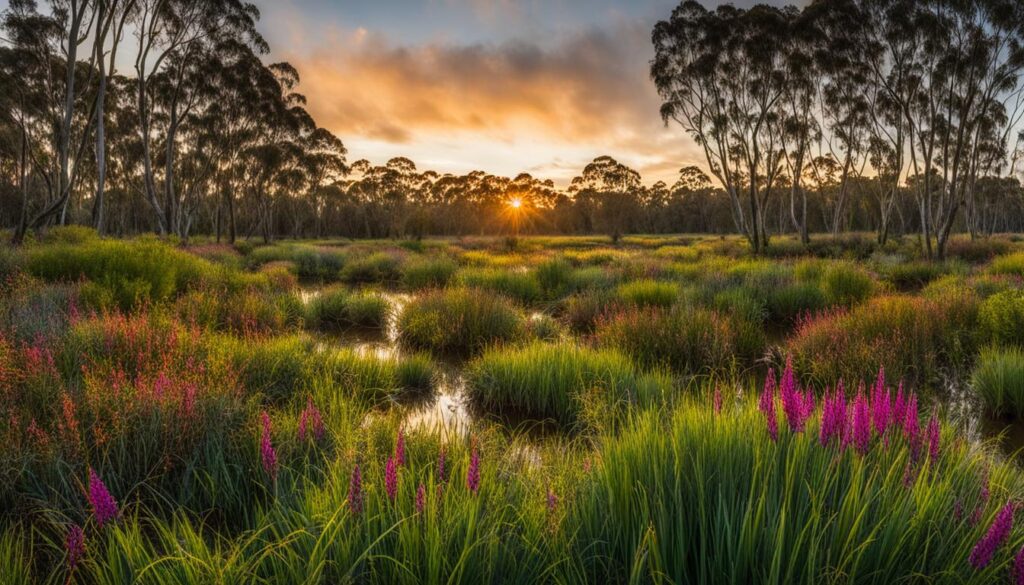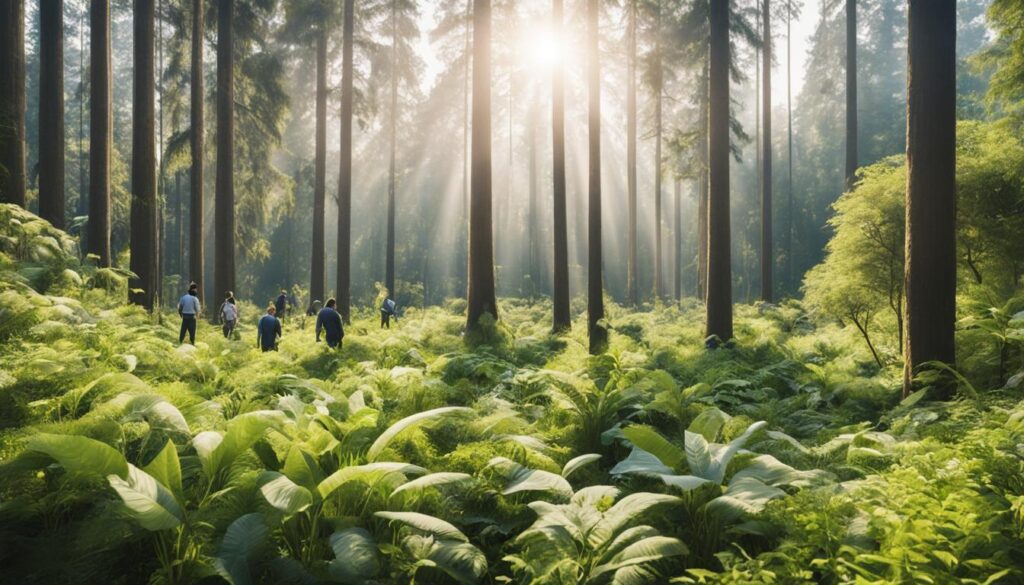Victoria’s Indigenous Planting Initiatives for Ecological Restoration play a vital role in restoring and preserving local ecosystems. Ecological restoration involves recreating and restoring natural habitats that have been degraded or destroyed by human activities such as land-use changes, pollution, and deforestation. Victoria’s Indigenous Planting Initiatives for Ecological Restoration focuses on using native plant species in the restoration process, which has proven to be more effective in promoting biodiversity and ecosystem function than non-indigenous plant species.
Key Takeaways:
- Victoria’s Indigenous Planting Initiatives for Ecological Restoration are essential for restoring and preserving local ecosystems.
- Using native plant species in restoration projects is more effective than non-indigenous species in promoting biodiversity and ecosystem function.
- Ecological restoration involves recreating and restoring natural habitats that have been degraded or destroyed by human activities.
- Victoria’s Indigenous Planting Initiatives for Ecological Restoration is a collaborative effort involving local communities, Indigenous groups, government agencies, and environmental organizations.
- The long-term benefits of Victoria’s Indigenous Planting Initiatives for Ecological Restoration are improved ecosystem health, increased resilience to climate change, and enhanced biodiversity.
Restoring Nature’s Balance through Indigenous Planting Programs
At the heart of Victoria’s ecological restoration efforts is the use of indigenous plants for ecological restoration. These plants are uniquely suited to the local environment, having evolved alongside native animals and other species. By restoring the balance of different plant communities, indigenous planting programs have the potential to enhance biodiversity and improve ecosystem health across Victoria.
Victoria’s Indigenous Planting Program is a notable initiative in this area. It aims to support the restoration of degraded ecosystems across the state by promoting the use of indigenous plant species. The program provides funding, technical advice, and other resources to landholders and community groups interested in undertaking ecological restoration projects.
There are many benefits to using indigenous plants for ecological restoration. These plants are often more resilient and drought-tolerant than exotic species, making them better equipped to deal with the challenges of climate change. They also play a crucial role in supporting local ecosystems, providing habitat for native animals and contributing to the overall health and diversity of the landscape.
The Benefits of Indigenous Planting Programs
Indigenous planting programs offer a range of benefits for both local ecosystems and the communities that rely on them. Some of the key benefits include:
- Promoting biodiversity and restoring native vegetation
- Improving soil health and nutrient cycling
- Enhancing habitat for native animals
- Reducing erosion and runoff
- Increase resilience to climate change and other environmental pressures
Overall, Victoria’s Indigenous Planting Program represents an important step forward in the effort to restore and preserve native ecosystems in the state. By working together with communities and landholders, we can help ensure a sustainable and healthy future for all.
Enhancing Biodiversity through Native Vegetation Restoration
Native vegetation restoration in Victoria plays a crucial role in promoting biodiversity and restoring the natural balance of local ecosystems. Unlike introduced plant species, native plants are better suited to the local climate and soil conditions, making them more resilient to environmental stresses and able to provide essential habitat and food sources for native wildlife.
Ecological restoration in Victoria involves the careful selection of indigenous plant species that are appropriate for the specific restoration site. This requires a thorough understanding of the local environment, including the soil type, moisture levels, and microclimate. By selecting the right mix of species, restoration projects can create habitat mosaics that cater to a diverse range of plant and animal species.
Victoria’s ecological restoration initiatives often involve partnerships with local communities, environmental organizations, and government agencies. These collaborative efforts ensure that native vegetation restoration projects are carefully planned, executed, and regularly monitored to maximize their success. They also provide opportunities for community involvement in the restoration process, fostering greater awareness and appreciation for the natural environment.

The benefits of native vegetation restoration in Victoria are wide-ranging and long-lasting. Restoration projects provide essential habitat and foraging opportunities for native wildlife, enhance ecosystem resilience, and contribute to the overall health and beauty of the natural environment. By promoting and investing in ecological restoration initiatives, we can ensure a sustainable and healthy environment for future generations.
The Importance of Ecological Restoration in Victoria
Ecological restoration initiatives play a crucial role in the conservation of natural resources, the protection of biodiversity, and the preservation of cultural heritage. In Victoria, these initiatives aim to restore land and water ecosystems, enhance their resilience to climate change, and promote sustainable development.
Victoria’s native plant restoration efforts are an essential component of ecological restoration projects. Native vegetation is critical to maintaining ecological functions, such as soil fertility, water quality, and carbon sequestration. Moreover, native plants provide food and habitat for local wildlife, support traditional knowledge and cultural practices, and improve the aesthetic and recreational value of natural areas.
Through ecological restoration initiatives in Victoria, we can restore the health and functionality of degraded ecosystems, mitigate the impacts of invasive species and human activities, and conserve the natural heritage of the region. Additionally, such initiatives can create employment opportunities, enhance community engagement and education, and foster a sense of pride and ownership in the local environment.
Victoria’s ecological restoration initiatives range from small-scale community-based projects to large-scale government-led programs, covering a diverse range of habitats, including forests, wetlands, grasslands, and coastal areas. These initiatives employ a variety of restoration methods, such as weed control, soil amendment, and plant propagation, and engage various stakeholders, such as landowners, volunteers, researchers, and policymakers.
The Benefits of Ecological Restoration in Victoria
The benefits of ecological restoration initiatives in Victoria are numerous and far-reaching. Some of the key benefits include:
- Promoting biodiversity by restoring habitats for threatened and endangered species
- Enhancing ecosystem services, such as pollination, carbon sequestration, and water filtration
- Improving soil health and fertility by restoring soil structure and nutrient cycling
- Reducing erosion and sedimentation by stabilising slopes and waterways
- Restoring cultural heritage and traditional knowledge by revitalising native vegetation and ecosystems
- Creating employment opportunities, particularly in regional and remote areas
- Fostering community engagement and participation in environmental management and decision-making
- Enhancing the resilience of ecosystems to the impacts of climate change and other stressors
The Challenges of Ecological Restoration in Victoria
Ecological restoration initiatives in Victoria face several challenges, including:
- Securing adequate funding and resources to support restoration projects
- Addressing the legacy of past land use practices, such as clearing, grazing, and mining
- Controlling and managing invasive species, which can outcompete native vegetation and disrupt ecosystem processes
- Adapting restoration strategies to changing climatic conditions and other environmental stressors
- Engaging diverse stakeholder groups and addressing conflicting interests and values
The Future of Ecological Restoration in Victoria
The future of ecological restoration in Victoria depends on the continued commitment and collaboration of all stakeholders involved in these initiatives. In the coming years, we can expect to see an increased focus on applying innovative restoration techniques, such as gene editing, assisted migration, and carbon farming, to achieve more efficient and effective outcomes. Moreover, we can anticipate greater attention to monitoring and evaluation of restoration projects to improve our understanding of ecological processes and inform future management decisions.
Identifying Indigenous Plant Species for Restoration Projects
Restoring damaged ecosystems requires a careful consideration of the site conditions and a thorough understanding of the species that can thrive in these conditions. Identifying the appropriate indigenous plant species for restoration projects is crucial for the success of these initiatives. Here are a few factors to take into account when choosing native plant species for restoration projects:
| Factor | Considerations |
|---|---|
| Site conditions | Soil type and moisture, climate, and topography. |
| Ecological compatibility | Ensure that the plant species are compatible with the existing ecosystem and the surrounding communities of plants and animals. |
| Diversity | Choose plant species that can promote diversity and enhance ecosystem resilience. |
| Availability | Choose plant species that are readily available for propagation and transplantation. |
It is also essential to consider the historical occurrence of plant species in the restoration area and consult with local Indigenous groups to include their traditional ecological knowledge in the process. The integration of Indigenous knowledge can help ensure that the chosen plant species are culturally significant and ecologically appropriate.
Victoria’s Indigenous Planting Program provides guidance and support for choosing native plant species for restoration projects in the region. The program emphasizes the importance of using indigenous plant species for ecological restoration and advocates for the preservation and restoration of the natural heritage of Victoria. The selection of appropriate plant species is crucial in achieving the program’s mission and ensuring the long-term success of restoration projects.

Implementing Indigenous Planting Initiatives for Ecological Restoration
Once suitable native vegetation species have been identified and restoration sites have been selected, the next step is to begin implementing indigenous planting initiatives. This process involves several important steps, including site preparation, planting techniques, and ongoing maintenance to ensure the success of the restoration project.
Site Preparation
Before any planting can occur, it is vital to properly prepare the restoration site. This may involve removing invasive species, tilling the soil, or creating raised beds for wetland restoration. In addition, some restoration sites may require additional soil amendments to ensure the successful growth of native plants.
Planting Techniques
Once the site is prepared, it is time to start planting. Depending on the location and site conditions, various planting techniques may be used, including direct seeding, plug planting, or container planting. Proper spacing and depth are crucial to ensure healthy growth and prevent overcrowding.
Ongoing Maintenance
After planting, ongoing maintenance is necessary to ensure the success of the restoration project. This may include regular watering, mulching, weeding, and controlling pests and diseases. Monitoring the site and adjusting plant care as needed is also crucial to ensuring the long-term success of the project.
In Victoria, the implementation of indigenous planting initiatives is supported by the Victoria’s Indigenous Planting Program. This program provides funding and resources to support the restoration of native plant species and promote ecological resilience throughout the region. By working together, we can continue to restore and protect Victoria’s natural ecosystems for generations to come.
Monitoring and Assessing the Success of Restoration Projects
It’s important to monitor and assess the success of ecological restoration initiatives in Victoria to ensure that they achieve their intended outcomes. One key method of evaluation is the use of ecological indicators, which provide information on the health and functionality of ecosystems. These can include measures of biodiversity, soil quality, vegetation cover, and water quality, among others.
Another approach to monitoring and assessment involves the use of remote sensing technologies such as aerial photography and satellite imagery. These tools can provide detailed information on changes in vegetation cover, land use, and other environmental factors over time.
Table: Selected Ecological Indicators for Monitoring and Assessment
| Ecosystem Component | Ecological Indicator |
|---|---|
| Vegetation | Species richness and abundance |
| Soil | Nutrient levels and composition |
| Water | Water quality and availability |
| Wildlife | Population numbers and distribution |
By monitoring these indicators, environmental managers can gain insights into the effectiveness of restoration strategies and make informed decisions about future management actions.
It’s also important to involve local communities in monitoring and assessment efforts, as they can provide valuable information on changes in their local environment and help to identify any emerging issues.

Overall, ongoing monitoring and assessment is crucial for the success of ecological restoration initiatives in Victoria, helping to ensure the continued health and resilience of local ecosystems for generations to come.
Collaborative Approaches to Ecological Restoration
In Victoria, meaningful ecological restoration initiatives require concerted efforts across different sectors of society. We greatly rely on the involvement of local communities, Indigenous groups, government agencies, and environmental organizations to achieve successful long-term outcomes.
Our collective approach to ecological restoration has strengthened the capacity of restoration projects in Victoria. It has enabled the sharing of knowledge and resources whilst providing opportunities for all involved to collaborate and contribute to achieving healthier ecosystems.
Through collaboration, local communities have acted as custodians of the land, identifying restoration areas and propagating native vegetation. This collaboration has been increasingly significant in the success of various restoration projects concerning larger ecological areas.
Notably, collaboration with Indigenous groups has led to greater understanding and inclusion of Indigenous knowledge and practices in ecological restoration efforts. Their involvement brings diversity to restoration approaches and supports the conservation of cultural heritage and the protection of important ecosystem services for future generations.
Government agencies have played a vital role by providing funding, governance and policy support to ecological restoration initiatives in Victoria. Through policy and funding, they have promoted ecological restoration activities and supported the development of Indigenous planting initiatives for ecological restoration.
Finally, environmental organizations such as Friends of the Earth and Birdlife Australia have also made significant contributions towards ecological restoration initiatives in Victoria through their collaborative engagement with local communities, scientific research and fundraising.
Long-Term Benefits and Future Outlook
Our commitment to Victoria’s Indigenous Planting Initiatives for Ecological Restoration is yielding significant long-term benefits. By restoring and preserving native vegetation, we are improving ecosystem health and fostering greater resilience to the challenges of climate change. We are also enhancing biodiversity by providing a habitat for native wildlife and promoting the growth of Indigenous plant species.
Moreover, Victoria’s Indigenous Planting Initiatives for Ecological Restoration are having a positive impact on local communities, as they provide opportunities for engagement and education. By involving community members in these initiatives, we are promoting a greater understanding of the importance of ecological restoration and inspiring future generations to take care of our precious natural environment.
Future Outlook
Looking ahead, we aim to continue our efforts in restoring and preserving Victoria’s unique ecosystems through the use of Indigenous planting programs. By collaborating with local communities, Indigenous groups, government agencies, and environmental organizations, we can make a lasting impact on the ecological health and resilience of our region.
Conclusion
In conclusion, Victoria’s Indigenous Planting Initiatives for Ecological Restoration are crucial for enhancing biodiversity and promoting ecosystem resilience. Through the use of indigenous plant species and collaborative restoration approaches, local communities, Indigenous groups, government agencies, and environmental organizations are working together to restore and preserve native vegetation in the region.
These initiatives not only contribute to the health and well-being of local ecosystems but also provide long-term benefits such as increased resilience to climate change and enhanced biodiversity.
As we continue to monitor and assess the success of restoration projects and identify suitable indigenous plant species for restoration, we are confident that Victoria’s Indigenous Planting Initiatives for Ecological Restoration will help to create a sustainable future for generations to come.
Join us in supporting these important restoration efforts to ensure the preservation and protection of our natural environment for the future.
FAQ
What are Victoria’s Indigenous Planting Initiatives for Ecological Restoration?
Victoria’s Indigenous Planting Initiatives for Ecological Restoration refer to the various programs and initiatives implemented in Victoria, Australia, to restore and enhance biodiversity through the use of indigenous plants. These initiatives aim to restore native vegetation, promote ecological resilience, and conserve local plant species.
Why is it important to use indigenous plants for ecological restoration?
Using indigenous plants for ecological restoration is important because they are adapted to the local environment, making them more resilient and better suited to support local ecosystems. Indigenous plants provide habitat for native fauna, improve soil health, prevent erosion, and promote biodiversity conservation.
What is Victoria’s Indigenous Planting Program?
Victoria’s Indigenous Planting Program is a government initiative that encourages the restoration of native vegetation through the promotion and use of indigenous plants. The program provides funding, technical support, and resources to landowners, community groups, and organizations involved in ecological restoration projects in Victoria.
How does native vegetation restoration contribute to biodiversity in Victoria?
Native vegetation restoration in Victoria contributes to biodiversity by providing habitat for native plant and animal species. Restoring native vegetation helps to recreate natural ecosystems, enhances ecological connectivity, and supports the survival and wellbeing of a wide range of native species.
What are some of the ecological restoration initiatives in Victoria?
Victoria has several ecological restoration initiatives, including the Victoria’s Indigenous Planting Program, the Revitalising Private Conservation in Victoria program, and the Biodiversity On-Ground Action program. These initiatives support the restoration of native vegetation, protection of threatened species, and conservation of biodiversity in various landscapes across the state.
How can I identify suitable indigenous plant species for restoration projects?
To identify suitable indigenous plant species for restoration projects, it is important to consider factors such as local climate, soil type, site conditions, and ecological compatibility. Consulting local plant guides, engaging with local experts, and conducting site assessments can help in selecting the appropriate indigenous plant species for a restoration project.
What are the practical steps involved in implementing indigenous planting initiatives for ecological restoration?
Implementing indigenous planting initiatives for ecological restoration typically involves site preparation, including weed control and soil conditioning, sourcing of indigenous plants from nurseries or seed banks, planting techniques such as direct seeding or planting seedlings, and ongoing maintenance to ensure plant survival and establishment.
How is the success of restoration projects monitored and assessed in Victoria?
The success of restoration projects in Victoria is monitored and assessed through various methods, including ecological surveys, vegetation monitoring, faunal surveys, and assessments of ecosystem function. Monitoring and assessment help in evaluating the ecological outcomes of restoration efforts, identifying any issues or challenges, and adapting restoration strategies accordingly.
How do collaborative approaches contribute to ecological restoration in Victoria?
Collaborative approaches, involving local communities, Indigenous groups, government agencies, and environmental organizations, play a vital role in ecological restoration in Victoria. Collaboration allows for the sharing of knowledge, resources, and expertise, and fosters a sense of ownership and stewardship among stakeholders, leading to more effective and sustainable restoration outcomes.
What are the long-term benefits of Victoria’s Indigenous Planting Initiatives for Ecological Restoration?
Victoria’s Indigenous Planting Initiatives for Ecological Restoration offer numerous long-term benefits. These initiatives contribute to improved ecosystem health, increased resilience to climate change, enhanced biodiversity conservation, and the preservation of Victoria’s unique native flora and fauna for future generations.
